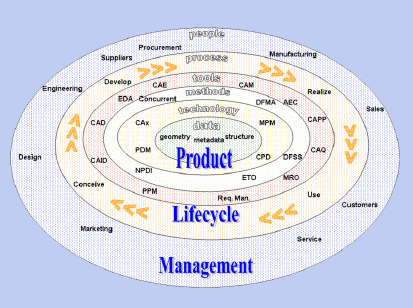Product Lifecycle Management Software
Definition: Product lifecycle management software is a suite of integrated computer-based tools for
managing the entire lifecycle of a product, from its conception and design to its manufacture,
sale and support.
The process of successfully bringing a product to market is rarely plain sailing. What the
consumer doesn’t see is the hundreds – and perhaps even thousands – of
projects and
processes that had to succeed before the product could reach the shelves of their local stores.
Manufacturing enterprises, however, are all too aware of what an enormous task it is to
successful create a new product, and the
risk it entails. In an effort to avoid the many pitfalls and stumbling
blocks that are found on the way to the shelves, many enterprises utilise product lifecycle
management software packages to help guide them through the process.
Features of PLM Software
 PLM software is not a single software product, but rather a collection of tools integrated
to manage the PLM process. These tools can include computer-aided design (CAD), enterprise
resource planning (ERP) and business process management (BPM) software, among others. PLM software is not a single software product, but rather a collection of tools integrated
to manage the PLM process. These tools can include computer-aided design (CAD), enterprise
resource planning (ERP) and business process management (BPM) software, among others.
When combined, these software tools help guide the product lifecycle through these broad phases:
Conception
From the moment a new product is conceived it must be developed with the marketplace in
mind. The initial phase of any product lifecycle will therefore rely heavily on customer
data, market research and focus groups. What will the product need to achieve to succeed?
What does the
customer require? Where will the product fit in the marketplace? The answers
to these questions allow the designers to frame the technical parameters of the product.
Design
Once a basic concept has been defined the product must be properly designed. The design
phase will usually be based within a
CAD framework, allowing developers to complete the
process from design conception and refinement through to stress testing using a single
software package.
The use of CAD software in the design and testing phases allows designers to make continuous
adjustments to the design based on testing data – something that would be much more time
consuming when physically performed.
Realisation
Once the product design has been finalised it is necessary to develop an efficient manufacturing
process to make the best use of production resources. Most enterprises will use some form of
manufacturing process management (MPM) software to convert the Bill of Materials (a list of
necessary parts for the product) into a Bill of Processes.
MPM software can also help in the design of the most efficient production line scenario,
reducing lead-time to the product launch and minimising work in progress (WIP) inventories.
The realisation phase may also involve the use of
computer-aided manufacturing software to
convert CAD product visualisations into operational code for numerical control machine tools,
further reducing the lead-time.
Service
The final phase of the product lifecycle is the service of the product. Customers and service
engineers must be provided with service information to allow them to repair or order the repair
of faulty products. While this phase may not seem as important as the design and manufacture of
the product, it is the most visible phase to the customer, and performing well will increase
customer satisfaction and improve customer retention.
The service phase largely revolves around using maintenance, repair and operations (MRO)
software to build a knowledge base containing maintenance and repair information for service
engineers, as well as warehouse management software to manage an inventor of replacement parts.
These resources should be made available to customer service representatives to allow for the
efficient management of product servicing.
Benefits of PLM Software
There are a great many benefits to be gained by using software tools to help manage a product
lifecycle, not least among which are:
Improved Product Quality
CAD software can allow developers to test, modify and retest products until they are fully
optimised. Using CAD software can slash the budget requirements of product development departments,
allowing
developers to get on with the job of designing rather than worrying about the development budget.
Reduced Time to Market
The streamlining of the manufacturing process using MPM tools can greatly reduce the development
phase, as well as reducing manufacturing time scales for general production.
Improved Business Intelligence
While all of these tools and applications are being used they are constantly accruing data on the
processes they optimise. This data can be used and re-used to optimise all future development cycles.
Reduced Cost
The increased speed and reduced waste that PLM software tools offer translates into direct savings
on the balance sheet, both from savings in the development process and optimisations to the
manufacturing process.
|
 PLM software is not a single software product, but rather a collection of tools integrated
to manage the PLM process. These tools can include computer-aided design (
PLM software is not a single software product, but rather a collection of tools integrated
to manage the PLM process. These tools can include computer-aided design (